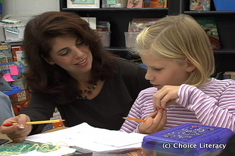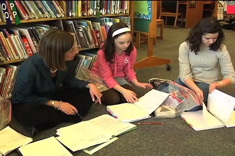Sitting around a crowded conference table, eight of my colleagues and I discuss the merits of using a writer’s notebook with our students. What started out as a study of how a teacher can use their own notebook to confer more effectively with students had turned in a new direction. As we talked, we discovered that we all had different ideas of what a writer’s notebook is and how it can or should be used in a classroom setting.
We decided to begin reading my book Notebook Know-How. The discussions that came from that book were as varied as the people in the room. This was the classic Louise Rosenblatt transactional theory of reading in real life — each teacher brought a different level of experience and expectation to her reading, and that colored their reading of my book. Even I found myself disagreeing or rewriting my own words as I read, based on my new experiences and expectations developed since I wrote that book almost seven years ago.
As we discussed and referred to the text, we realized a few things. Some participants weren’t keeping their own notebooks, and we had very different beliefs about the whole writer’s notebook concept. This surprised me, because I am not always in conversations where teachers are truly questioning the concept of a writer’s notebook. I’m often the consultant, the author, and the so-called “expert” in the room. In those situations, the value of a notebook is a given. This time, among colleagues with different histories and experiences. I was able to see myself again as a classroom teacher (not any kind of expert or notebook sage). The conversations really helped me rethink writer’s notebooks in the classroom.
We decided that each member of the group would think about and share five beliefs they had about writer’s notebooks in a classroom setting. We limited these believes to classroom settings, because the nature of children and the confines of a classroom are different from the nature and environment of an adult writer scribbling away in the notebook.
After rereading of my book, Ralph Fletcher’s writing on notebooks, and scouring the web for insights, I began to draft and revise my five core beliefs. I’ll share them here, with the note that as I continue to learn more about the art of teaching writing, I plan to evolve in my understanding of notebooks as a tool to help my students live writerly lives.
My Core Beliefs About Notebooks
1. A writer’s notebook is a place where writers explore their thinking. This exploration may look different from writer to writer – from ideas written on napkins and taped in to a notebook to fleshed-out story ideas. The notebook holds all the ‘stuff’ writers don’t know what to do with yet . . . or ever.
2. A writer’s notebook is a reflection of who that writer is at a point in time of her life. It not only reflects the writer’s ideas and thinking, but it also reflects her style, language knowledge, and sense of her place in the world. Thus, anything a writer finds significant — or write worthy — will be in the notebook. From small moments to big celebrations, from memories to future plans, writers use everything available to them to create their own voice. It’s important for teachers not to insert themselves in this kind of writing. The notebook shouldn’t be a reflection of the teacher.
3. Notebooks are tools that require writers to make decisions. Notebook decisions range from the topic and length to the format and type of writing tool used in a piece of writing. Writers have to be decisionmakers, and the more practiced a writer is at thinking about his work, the more purposeful he can be when moving on to a writing project outside of the notebook.
4. Rereading one’s notebook helps writers explore topics more deeply or in a new way. Writing about a topic for an entry and leaving that idea forever seems wasteful. It’s important for a writer to become habitual about reading her own work. Yes, she may find some errors, but in the notebook the point would be to read like a writer and think about the possibilities an entry or topic may have. This habit then becomes a valuable technique when revising and editing her work. It’s amazing how many students will say they have revised or edited their work without even rereading it thoughtfully.
5. As a writer becomes more diligent about keeping a notebook, his notebook will evolve in its purpose. As he organizes his way of thinking and writing, he’ll change the ways and kinds of notebooks he uses to meet these different purposes. Many adult writers keep several notebooks. I have a mini-one in my purse, one for professional conferences, one for my work with children, and one for myself. Each notebook has a purpose. I don’t write in each one every day, but I write each day in one of them, depending on what kind of writing I decide to work on that day. In school, this may seem cumbersome. Most students won’t get to this point the first year or two they keep a writer’s notebook. But, when they’re out of school — for the summer or even on the weekends — kids will start their own notebooks. I’ve had children tell me (and show me) their notebooks just for poetry or fiction or turtle observations. This makes my day, when children internalize the concept and make it their own.
From Belief to Practice: Teaching with Notebooks
From these beliefs I make some teaching decisions. Here are a few:
1. I refer to notebook writing as entries, not drafts or stories. The word draft should imply future revising and editing — that there is an audience other than the writer. The student is the primary reader of her own writer’s notebook, so the word draft would be misused in this situation. I also veer away from using the word story in the writer’s notebook. When children finish a story, they often mean it’s finished. Done. And they often want others to read it — as is. It’s not meant to be reread for lifting a line or to notice any writing territories and patterns. So, stories should be outside of the notebook.
2. By drafting outside the notebook, my students are forced to make decisions about their writing and to refocus their efforts for the different stages of the writing process. Drafting makes way for revisions and editing. Drafting also reminds the writer that he is now writing for an audience, not himself. This changes the stance and approach a writer takes to his work.
3. Students need guidance and support in establishing and maintaining a writer’s notebook. Some children naturally envision exactly how they want to keep their notebook. Many children, however, will simply look at the blank pages and feel overwhelmed. When kids ask what they should write about, it’s a clue to the teacher that they need guidance and support for how to live like a writer and keep a notebook. There is direct teaching in this manner. I teach strategies to find ideas. I model how I reread entries to find places and ways to write more deeply or in a different fashion. I guide students during my writing conferences by teaching them during the writing process what they need to know next based on their individual needs. This is not the support an editor gives to a professional writer. Rarely, if ever, will an editor read a writer’s notebook. They don’t jump in until the revision stage. As teachers of children, we need to jump in sooner.
These are my beliefs for now and the teaching decisions that stem from those beliefs. It’s been a good thing to take stock on something I’ve been doing for awhile and to reflect on how my own thinking has evolved.
What are some beliefs that you and your colleagues hold true about writer’s notebooks?
What are the teaching decisions you make based on those beliefs?









